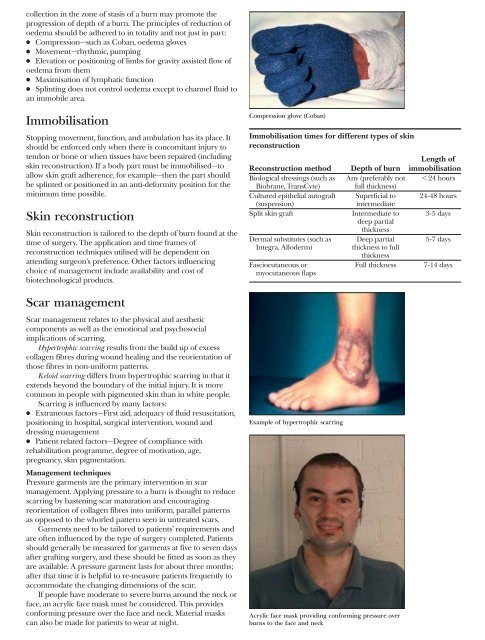ABC of Burns
You also want an ePaper? Increase the reach of your titles
YUMPU automatically turns print PDFs into web optimized ePapers that Google loves.
collection in the zone <strong>of</strong> stasis <strong>of</strong> a burn may promote the<br />
progression <strong>of</strong> depth <strong>of</strong> a burn. The principles <strong>of</strong> reduction <strong>of</strong><br />
oedema should be adhered to in totality and not just in part:<br />
x Compression—such as Coban, oedema gloves<br />
x Movement—rhythmic, pumping<br />
x Elevation or positioning <strong>of</strong> limbs for gravity assisted flow <strong>of</strong><br />
oedema from them<br />
x Maximisation <strong>of</strong> lymphatic function<br />
x Splinting does not control oedema except to channel fluid to<br />
an immobile area.<br />
Immobilisation<br />
Stopping movement, function, and ambulation has its place. It<br />
should be enforced only when there is concomitant injury to<br />
tendon or bone or when tissues have been repaired (including<br />
skin reconstruction). If a body part must be immobilised—to<br />
allow skin graft adherence, for example—then the part should<br />
be splinted or positioned in an anti-deformity position for the<br />
minimum time possible.<br />
Skin reconstruction<br />
Skin reconstruction is tailored to the depth <strong>of</strong> burn found at the<br />
time <strong>of</strong> surgery. The application and time frames <strong>of</strong><br />
reconstruction techniques utilised will be dependent on<br />
attending surgeon’s preference. Other factors influencing<br />
choice <strong>of</strong> management include availability and cost <strong>of</strong><br />
biotechnological products.<br />
Compression glove (Coban)<br />
Immobilisation times for different types <strong>of</strong> skin<br />
reconstruction<br />
Reconstruction method<br />
Biological dressings (such as<br />
Biobrane, TransCyte)<br />
Cultured epithelial autograft<br />
(suspension)<br />
Split skin graft<br />
Dermal substitutes (such as<br />
Integra, Alloderm)<br />
Fasciocutaneous or<br />
myocutaneous flaps<br />
Length <strong>of</strong><br />
Depth <strong>of</strong> burn immobilisation<br />
Any (preferably not < 24 hours<br />
full thickness)<br />
Superficial to 24-48 hours<br />
intermediate<br />
Intermediate to 3-5 days<br />
deep partial<br />
thickness<br />
Deep partial 5-7 days<br />
thickness to full<br />
thickness<br />
Full thickness 7-14 days<br />
Scar management<br />
Scar management relates to the physical and aesthetic<br />
components as well as the emotional and psychosocial<br />
implications <strong>of</strong> scarring.<br />
Hypertrophic scarring results from the build up <strong>of</strong> excess<br />
collagen fibres during wound healing and the reorientation <strong>of</strong><br />
those fibres in non-uniform patterns.<br />
Keloid scarring differs from hypertrophic scarring in that it<br />
extends beyond the boundary <strong>of</strong> the initial injury. It is more<br />
common in people with pigmented skin than in white people.<br />
Scarring is influenced by many factors:<br />
x Extraneous factors—First aid, adequacy <strong>of</strong> fluid resuscitation,<br />
positioning in hospital, surgical intervention, wound and<br />
dressing management<br />
x Patient related factors—Degree <strong>of</strong> compliance with<br />
rehabilitation programme, degree <strong>of</strong> motivation, age,<br />
pregnancy, skin pigmentation.<br />
Management techniques<br />
Pressure garments are the primary intervention in scar<br />
management. Applying pressure to a burn is thought to reduce<br />
scarring by hastening scar maturation and encouraging<br />
reorientation <strong>of</strong> collagen fibres into uniform, parallel patterns<br />
as opposed to the whorled pattern seen in untreated scars.<br />
Garments need to be tailored to patients’ requirements and<br />
are <strong>of</strong>ten influenced by the type <strong>of</strong> surgery completed. Patients<br />
should generally be measured for garments at five to seven days<br />
after grafting surgery, and these should be fitted as soon as they<br />
are available. A pressure garment lasts for about three months;<br />
after that time it is helpful to re-measure patients frequently to<br />
accommodate the changing dimensions <strong>of</strong> the scar.<br />
If people have moderate to severe burns around the neck or<br />
face, an acrylic face mask must be considered. This provides<br />
conforming pressure over the face and neck. Material masks<br />
can also be made for patients to wear at night.<br />
Example <strong>of</strong> hypertrophic scarring<br />
Acrylic face mask providing conforming pressure over<br />
burns to the face and neck



